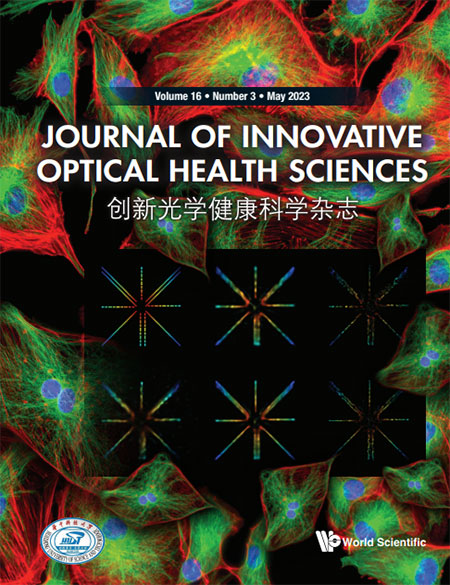Research on the detection of early caries based on hyperspectral imaging
Abstract
Objective: We applied hyperspectral imaging (HSI) system to distinguish early caries from sound and pigmented areas. It will provide a theoretical basis and technical support, for research and development of an instrument that could be used for screening and detection of early dental caries.
Methods: Eighteen extracted human teeth (molars and premolars), with varying degrees of natural pathology and no degree of decay involving dentin were obtained. HSI system with a wavelength range from 400 to 1000nm was used to obtain images of all 18 teeth containing sound, carious and pigmented areas. We compared the spectra of the wavebands at both 500nm and 780nm from the different tooth states, and the reflectance difference between sound versus carious lesions and sound versus pigmented areas, respectively.
Results: There was a slight difference in reflectance between carious areas and pigmented areas at 500nm. A substantial difference was additionally noted in reflectance between carious areas and pigmented areas at 780nm.
Conclusion: The results have shown that the interference of tooth surface pigment can be eliminated in the near-infrared (NIR) waveband, and the caries can be effectively identified from the pigmented areas. Thus, it could be used to detect carious areas of teeth in place of the traditional visual inspection method or white light endoscopy.
Clinical significance: The NIR diffused light signal enables the identification of early caries from pigment and other interference, providing a reasonable detection tool for early detection and early treatment of teeth diseases.
References
- 1. , “Fluorescence spectrometry based chromaticity mapping, characterization, and quantitative assessment of dental caries,” Photodiagn. Photodyn. Ther. 37, 102711 (2022). Crossref, Web of Science, Google Scholar
- 2. , “Near infrared transillumination compared with radiography to detect and monitor proximal caries: A clinical retrospective study,” J. Dent. 70, 40–45 (2018). Crossref, Web of Science, Google Scholar
- 3. , “Accuracy of near-infrared light transillumination (NILT) compared to bitewing radiograph for detection of interproximal caries in the permanent dentition: A systematic review and meta-analysis,” J. Dent. 98, 103351 (2020). Crossref, Web of Science, Google Scholar
- 4. , “Automated classification of dual channel dental imaging of auto-fluorescence and white lightby convolutional neural networks,” J. Innov. Opt. Heal. Sci. 5, 2050014 (2020). Link, Web of Science, Google Scholar
- 5. , “Medical hyperspectral imaging: A review,” J. Biomed. Opt. 19(1), 010901 (2014). Crossref, Web of Science, Google Scholar
- 6. , “Hyperspectral imaging in the medical field: Present and future,” Appl. Spectrosc. Rev. 49(6), 435–447 (2014). Crossref, Web of Science, Google Scholar
- 7. , “A review of the medical hyperspectral imaging systems and unmixing algorithms’ in biological tissues,” Photodiagn. Photodyn. Ther. 33, 102165 (2021). Crossref, Web of Science, Google Scholar
- 8. , “Spatial-spectral identification of abnormal leukocytes based on microscopic hyperspectral imaging technology,” J. Innov. Opt. Heal. Sci. 13(2), 2050005 (2020). Link, Web of Science, Google Scholar
- 9. , “Near-infrared hyperspectral imaging of water evaporation dynamics for early detection of incipient caries,” J. Dent. 42(10), 1242–1247 (2014). Crossref, Web of Science, Google Scholar
- 10. , “Laser induced fluorescence with 2-D Hilbert transform edge detection algorithm and 3D fluorescence images for white spot early recognition,” Spectrochim. Acta A Mol. Biomol. Spectrosc. 240, 118616 (2020). Crossref, Web of Science, Google Scholar
- 11. , “Design and implementation of novel hyperspectral imaging for dental carious early detection using laser induced fluorescence,” Photodiagn. Photodyn. Ther. 24, 166–178 (2018). Crossref, Web of Science, Google Scholar
- 12. , “Classification of dental diseases using hyperspectral imaging and laser induced fluorescence,” Photodiagn. Photodyn. Ther. 25, 128–135 (2019). Crossref, Web of Science, Google Scholar
- 13. , “Identifying the incidence level of periodontal disease through hyperspectral imaging,” Opt. Quantum Electron. 50(11), 1–14 (2018). Crossref, Web of Science, Google Scholar
- 14. , “Visual perception enhancement for detection of cancerous oral tissue by multi-spectral imaging,” J. Opt. 15(5), 055301 (2013). Crossref, Google Scholar
- 15. , “Hyperspectral imaging and artificial intelligence to detect oral malignancy - part 1 - automated tissue classification of oral muscle, fat and mucosa using a light-weight 6-layer deep neural network,” Head Face Med. 17(1), 38 (2021). Crossref, Web of Science, Google Scholar
- 16. , “Multimodal hyperspectral fluorescence and spatial frequency domain imaging for tissue health diagnostics of the oral cavity,” Biomed. Opt. Exp. 12(11), 6954–6968 (2021). Crossref, Web of Science, Google Scholar
- 17. , “Optimal lighting of RGB LEDs for oral cavity detection,” Opt. Exp. 20(9), 10186–10199 (2012). Crossref, Web of Science, Google Scholar
- 18. , “The diagnostic efficacy of quantitative light-induced fluorescence in detection of dental caries of primary teeth,” J. Dent. 115, 103845 (2021). Crossref, Web of Science, Google Scholar
- 19. , “Optical detection of the potential for tooth discoloration from children’s beverages by quantitative light-induced fluorescence technology,” Photodiagn. Photodyn. Ther. 34, 102240 (2021). Crossref, Web of Science, Google Scholar
- 20. , “Application of optical and spectroscopic technologies for the characterization of carious lesions in vitro,” Biomed. Tech. (Berl). 63(5), 595–602 (2018). Crossref, Web of Science, Google Scholar
- 21. , “HeNe-laser light scattering by human dental enamel,” J. Dent. Res. 74(12), 1891–1898 (1995). Crossref, Web of Science, Google Scholar
- 22. , “Propagation of light through human dental enamel and dentine,” Caries Res. 29, 8–13 (1995). Crossref, Web of Science, Google Scholar
- 23. , “Nature of light scattering in dental enamel and dentin at visible and near-infrared wavelengths,” Appl. Opt. 34(7), 1278–1285 (1995). Crossref, Web of Science, Google Scholar
- 24. , “Near-infared hyperspectral imaging of teeth for dental caries detection,” J. Biomed. Opt. 14(6), 064047 (2009). Crossref, Web of Science, Google Scholar


